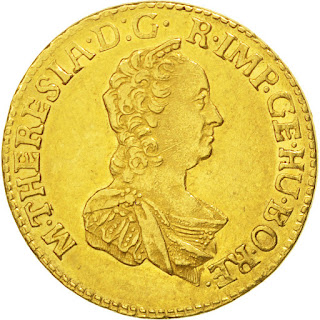Transylvania 2 Ducat Gold Coin 1765 Empress Maria Theresa
Obverse: outer pearl circle, Diademed bust of Empress Maria Theresa facing left and legend: M · THERESIA · D:G · R · IMP · GE · HU · BO · REG ·
Reverse: outer pearl circle, inside the double headed eagle holding the Crowned arms of Transylvania on its chest, value 2 and legend: TRAN · COTYR · 1765 · AR · AU · DUX · BU · ME · P
Composition: Gold.
Fineness: 0.986.
Weight: 7.0000 g.
AGW: 0.2219 oz.
Karlsburg Mint in Transylvania.
The legend starts on the obverse and ends on the reverse: M · THERESIA · D:G · R · IMP · GE · HU · BO · REG · TRAN · COTYR · 1765 · AR · AU · DUX · BU · ME · P , standing for
M[ARIA] THERESIA D[EI] G[RATIA] R[OMANORUM] IMP[ERATRIX] HU[NGARIAE] BO[HEMIAE] REG[INA] TRAN[SYLVANIAE] CO[MES] TYR[OLIS] AR[CHIDUX] AU[STRIAE] DUX BU[RGVNDIAE] [ET] ME[DIOLANUM] P[RINCEPS]
and meaning Maria Theresa, by the grace of God empress of the Romans, queen of Hungary and Bohemia, archduchess of Austria, duchess of Burgundy and Milan, princess of Transylvania and countess of Tirol.
Medieval Transylvanian mintage knows a few main evolutionary periods: the period of the Hungarian kingdom that struck coin inside the Carpathian space (close to the gold mines, to say so), autonomous principality period (under Turkish suzerainity), Habsburg period up to Maria Theresa during which properly called Transylvanian coins kept on being struck (bearing the face of either the emperor or the empress, but also the coat of arms of the principality) and the last one that reminds of Transylvania only through mint ensigns on regular imperial coins.
The life of the autonomous Transylvanian principality under Habsburgs lasted from 1691 to 1867, when Austro-Hungarian dualism brought it to an end. The principality enjoyed a separate statute (endorsed by the Leopoldian Diploma), being direct subject of the emperor. Through the Carlowitz peace (1699) and the one of Passarowitz (1718) the Porte was compelled to acknowledge Austrian domination in Transylvania.

